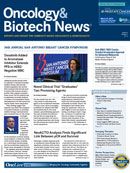Publication
Article
Oncology & Biotech News
Rare Type of Leukemia Responds to Melanoma Treatment Vemurafenib
Author(s):
Vemurafenib (Zelboraf), a BRAF inhibitor approved to treat melanoma, induced a complete clinical remission in a patient with hairy cell leukemia.
(left to right) Jesvin Samuel, PhD student, University of Leicester; Salvador Macip, MD, PhD, University of Leicester Department of Biochemistry; and Martin Dyer, MA, DPhil, professor of Haemato-Oncology, University of Leicester.
Vemurafenib (Zelboraf), a BRAF inhibitor approved to treat melanoma, induced a complete clinical remission in a patient with hairy cell leukemia (HCL), according to researchers at the University of Leicester. The treatment cleared malignant cells from the patient’s blood and reduced the viability of CD103+ HCL cells, the researchers reported in The New England Journal of Medicine.
The BRAF V600E mutation is present in nearly all cases of HCL. The patient in the report had purine-analogue—refractory HCL and biallelic BRAF V600E mutations. He had exhausted all standard treatment options and previous research has shown that vemurafenib has activity in HCL.
“Because our patient had become resistant to the drugs of choice for HCL, we asked permission to treat him with vemurafenib, which has only been approved for melanomas to date. We wanted to see if the drug was effective and how it was killing the malignant cells,” said Salvador Macip, MD, PhD, University of Leicester Department of Biochemistry, in an interview with Oncology & Biotech News. Macip conducted the research along with his colleagues Martin Dyer, MA, DPhil, professor of Haemato-Oncology at the University of Leicester, and Jesvin Samuel, a PhD student at the University of Leicester.
Hematologic recovery began after 2 months of treatment. The complete blood count was monitored daily in samples obtained from the patient before the first daily dose of vemurafenib. The researchers reported that BRAF activity was reduced by 75%/day after treatment and reduced by 90% by day 8.
“Our results are similar to those of a few previous reports also showing clinical effects of vemurafenib in HCL.This strongly suggests that it could successfully be used as a treatment for HCL, at least the resistant forms, and we hope it will eventually be approved for this purpose,” said Macip.
If a new indication were sought for vemurafenib, the prevalence of BRAF V600E mutations in HCL and the fact that the drug is already approved for clinical use could shorten the regulatory review time.
However, Macip cautions that “more research needs to be done to assess the benefit of the drug in HCL patients and to find ways to prevent the eventual emergence of resistant cells.”
An additional interesting finding from the study is that the drug worked differently than expected. When BRAF activation occurs, constitutive phosphorylation of ERK and MEK is thought to be a direct response. However, this mechanism of action was not observed by Macip et al.
“Although BRAF was inhibited, the downstream pathway— ERK and MEK—remained activated,” said Macip. This was demonstrated by both immunoblot and flow cytometry, despite prolonged exposure to vemurafenib. “Together with our previous results showing that vemurafenib does not affect malignant B-cell viability in vitro, this suggests that the drug acts through a context-dependent mechanism that has not yet been elucidated,” said Macip.
These findings related to the mechanism of vemurafenib in HCL are critical to the development of future studies examining potential treatment combinations, the authors wrote.
Samuel J, Macip S, Dyer MJ. Efficacy of vemurafenib in hairy-cell leukemia. N Engl J Med. 2014;370(3):286-288.










